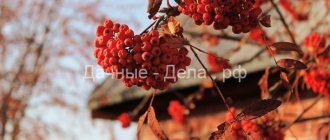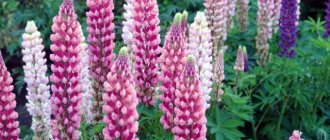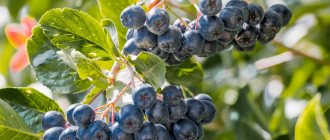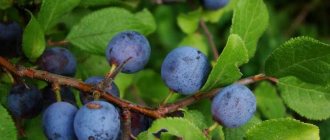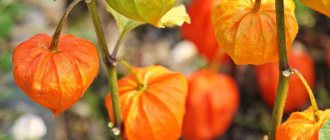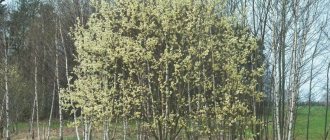Rhubarb (Rheum) is a herbaceous perennial that is a member of the Buckwheat family. This plant is most common in nature in the United States and Europe, but it can also be found in Asia. Rhubarb has a rather complicated origin story. Mention of it was found in the writings of Pedanius Dioscorides, who lived in the 1st century AD. Such crops began to be brought to Europe from Asia through Persia in the 11th–12th centuries. After Marco Polo visited the Tangut kingdom, he said that the root of this plant was grown and harvested there in large quantities. Rhubarb root came to England in 1640; it was imported from China through India, which is why the British called it a Chinese, Cantonese or East Indian vegetable. This culture presumably came to the territory of modern Russia from the Crimean Peninsula.
Brief description of cultivation
- Sowing . Sowing seeds in open soil is carried out in the first days of October or in February–March. And they are sown for seedlings in the first days of April, while the plants are planted in open soil in August or in the first days of September.
- Illumination . Grows well in shaded and sunny places, as well as in areas with diffused light.
- Soil . Suitable soil should drain water well and be moist, and it should also contain a large amount of humus. Optimal pH 4.5.
- Watering . It is necessary to water abundantly and systematically. During the season, this procedure is carried out 3 or 4 times, while 3–4 buckets of water are consumed per 1 square meter.
- Fertilizer . During the summer period, rhubarb needs to be fed 1 or 2 times; for this, organic matter or mineral fertilizer is used. Once every 4–5 years, 1–2 buckets of humus should be added to each bush. It is recommended to feed rhubarb with organic fertilizers in the autumn, and with mineral fertilizers in the spring.
- Reproduction . By division of rhizomes and seed method.
- Harmful insects . Heartworm caterpillars, onion nematodes and rhubarb weevil.
- Diseases . Ramularia, ascochyta blight, powdery mildew and rust.
- Properties . This plant contains biologically active substances, so it has healing properties.
Features of rhubarb
The woody, branched rhizome of rhubarb is dark brown in color and reaches 40–60 mm in diameter; there are many small roots on its surface. The lifespan of the root of such a plant is 12 years or more. Thick, hollow, straight, slightly grooved stems are annual. Large basal leaf plates are solid, palmate-lobed or serrated, and they are often wavy along the edge. The foliage has long petioles, which are cylindrical or multifaceted, with wide flares at their base. The rosette leaf blades are much larger than the stem blades. The stem is weakly branched and erect, its height is about 250 cm. On the surface of the straight, tall peduncles there are many red spots; they end in paniculate inflorescences, which include bisexual small flowers of pale green, red, white or pink. If the flowers grow underdeveloped, they may be unisexual. Flowering is observed in the last days of May or the first days of June. The fruit is a brownish-red triangular nut, the length of which is from 70 to 100 mm. The root of this plant, as well as its leaf petioles, have medicinal properties.
Rhubarb: benefits, cultivation, use.
Tukumsky 5
This perennial is grown throughout Russia. Ripe petioles are used in cooking and for preservation. The rhubarb variety Tukumsky 5 has decorative properties and is classified as a table variety.
Characteristics:
- petiole length – 50-70 cm;
- weight – 100-106 g;
- taste – pleasant, sour with notes of sweetness;
- yield - up to 4.3 kg per 1 sq. m;
- mid-season variety: harvested 35-45 days after the appearance of the first shoots.
Advantages of the variety:
- relative resistance to diseases such as brown spot and ascochyta;
- high yield rates;
- frost resistance.
Sowing rhubarb for seedlings
When to plant rhubarb for seedlings
Rhubarb can be grown from seeds, but this process is quite labor-intensive, and the resulting plants will produce their first harvest only after several years. However, this method allows you to have a tasty and healthy vegetable on your table for many years. Seed material can be purchased in specialized agricultural stores, or you can also buy it in an online store, but it must be reliable and have a good reputation.
Seed preparation should be started four days before sowing day. To do this, they are filled with water at room temperature, where they will swell for 10 hours. Then they are immersed for 1 hour in a pink potassium manganese solution for disinfection. After this, the seed is transferred to a moistened cloth, and all that remains is to wait for the seeds to hatch.
Sowing of seedlings is carried out in the first days of April, for this they use pots reaching 10–12 centimeters in diameter. The seeds need to be buried 20–30 mm into the substrate. Before the seedlings appear, you need to ensure that the soil mixture in the containers is always a little damp.
Caring for rhubarb seedlings
The appearance of the first shoots is observed 15–20 days after sowing. As soon as this happens, the pots with plants should be immediately moved to a well-lit place. Growing rhubarb seedlings is quite simple; to do this, you need to water them in a timely manner, loosen the surface of the soil mixture, and also feed them regularly (once every 1.5 weeks).
Plants need to be cared for throughout the summer. They are transplanted into open soil only 90–100 days after sowing the seeds; as a rule, this time occurs in August or the first days of September. The fact is that the planted seedlings must have time to take root well before winter comes.
Rhubarb through seedlings. Sowing.
Obsky
A perennial with tender pulp, the fruits of which are used for processing, making jam and compotes. The variety is suitable for cultivation throughout Russia.
Characteristics:
- petiole length – 22-23 cm;
- average weight – 44-84 g;
- taste – sweet and sour;
- the yield is small - 1.6-2.1 kg per 1 sq. m;
- mid-season variety: technical ripeness occurs 30-39 days after the appearance of full shoots.
Advantages of the Obsky variety:
- frost resistance;
- high decorative qualities;
- resistance to waterlogging.
Growing rhubarb from seeds in the garden
Planting rhubarb in the ground
Since rhubarb is distinguished by its frost resistance, its seeds can be sown immediately in open soil. But when is the best time to do this? Seed sowing is carried out at the beginning of the spring period (in March, or possibly in February). This can also be done before winter in mid-October. This crop is not only frost-resistant, but also unpretentious, so growing it on your own plot is quite simple.
For sowing, you can choose either a well-lit nook in the garden or a shaded place under the canopy of fruit trees. Suitable soil should be moist, drain well, contain a large amount of humus and have an acidity pH of 4.5. The preparation of the site should be done several months before sowing; for this purpose, it is dug up and humus is added to the soil (3 buckets per 1 square meter of site). In the same place, such a crop can be grown for 15 years or even longer.
Sowing rules
To begin with, the seed must be prepared and germinated; this is done in the same way as when sowing rhubarb for seedlings (see above). Then the seeds are densely laid out in pre-prepared grooves, the depth of which is 10–15 mm, the distance between them should be from 20 to 25 centimeters. Then the seeds are planted. If pre-winter sowing is carried out, the bed should be mulched with garden compost, leaf humus or other organic material, and the layer thickness should be about 10 mm. If sowing was carried out in the spring, then the bed will need to be mulched only after the seedlings appear. It is also necessary to mulch the bed immediately after transplanting the seedlings into open soil.
Whether with spring or winter sowing, the first shoots can be seen only in the spring, but it must be taken into account that the seed of such a plant has low germination. From the middle to the end of May, when 1 or 2 true leaf blades have formed on the plants, the plants will need to be planted, adhering to the 10x10 centimeters pattern.
Growing rhubarb
Rhubarb care
Caring for rhubarb crops before the onset of autumn consists of systematic watering, timely removal of weeds, loosening the soil surface around the bushes, and they also need to be fed with complex mineral fertilizer once every 1.5 weeks. With the beginning of the autumn period, they stop watering and feeding rhubarb, and at this time they should start transplanting the seedlings to a permanent place, however, some gardeners prefer to grow them in a school for another 1 year. When transplanting seedlings to a permanent place, it should be remembered that the feeding area for one bush must be at least 1 square meter.
How to water
To keep the petioles large, the bushes need to be watered systematically and abundantly. Over the course of one season, such a crop is watered 3 or 4 times, while 3 to 4 buckets of water are consumed per 1 square meter of land. The less frequent and sparing the watering, the greater the amount of oxalic acid will be contained in the petioles.
After flower stalks form on the bush, they should be removed. The fact is that due to the growth of peduncles, foliage and petioles develop and grow much more slowly. When the rhubarb is watered, it is recommended to loosen the surface of the soil around it, and pull out all the weeds.
Feeding rhubarb
During one season, such a plant will need 1 or 2 feedings with liquid complex mineral or organic fertilizer, for example, you can use a mullein solution (0.5 liters of mullein per 1 bucket of water). In addition, once every 4 or 5 years, 10–20 liters of manure or humus must be added to each bush. In the spring, it is recommended to use mineral fertilizers to feed this crop, and in the autumn, organic matter is better suited for this.
Wintering
In the summer, the bush should be rejuvenated; to do this, you need to cut off all the foliage with cuttings, leaving only 2 or 3 leaf blades so that the rhubarb can feed normally. By autumn, foliage will grow on the bush again, and 1/3 of them can be cut off for food, and 2/3 of the leaf blades must be left on the plant, in which case it will be able to properly prepare for wintering. To protect rhubarb from freezing, it must be covered with dry soil or fallen leaves on top. With the onset of spring, the shelter is removed from the plant so that it can grow foliage.
Harvesting
Harvesting vegetable rhubarb petioles begins only from 2–3 years, since the plant needs the first year or two to take root well and gain strength for its development.
Rhubarb petioles are collected quite early, in the first half of May, before other spring vegetable crops begin to ripen, for which this plant is valued. The petioles are not cut off, but carefully broken off, making sure to leave a third of the leaves on the plant (at least 20%). Harvest in 2–3 steps, breaking out no more than 3–5 leaves at a time.
As the temperature increases, the rhubarb leaf ages, accumulates oxalic acid and becomes unfit for consumption. The very first leaves are equal in vitamin content to apples, and in some indicators they even surpass them.
Each rhubarb bush produces up to 30 marketable leaves. Their petioles, depending on the varietal characteristics, can reach a length of 70 cm or more, and have a thickness of 4–5 cm. The weight of a commercial petiole ranges from 100 to 300 g.
The external color may vary depending on the variety - from green to burgundy. The flesh also has different colors: it can be green, shades of red, and even dotted with red. In addition, varieties differ both in the density of the pulp and in the shape of the petiole, which can be concave with elongated edges, without them, or simply round. The surface of the petiole can be ribbed or smooth.
On a note! Many people prefer rhubarb varieties with rounded petioles, as they produce less waste during processing. And also varieties with erect, rather than inclined leaves towards the ground, since such plants are more convenient to care for.
In order for rhubarb petioles to be stored better, the leaf plate is not completely removed from them, leaving a small part, and the film scale at the base is not removed. For better preservation, the freshly harvested crop is wrapped in paper, placed in a bag and placed in the refrigerator. However, even in this case, it is better to use it within a maximum of 20 days. If long-term storage is necessary, the petioles are cut into slices about 2 cm long and frozen.
The collection of roots and rhizomes begins at 4–5 years of plant life. It is held in the summer. Rhubarb roots are first dried in the open air for up to 2 weeks, then dried at a temperature of 60 °C. The finished raw material - pieces of rhizomes no more than 25 cm long and 3 cm thick - has an astringent, bitter taste. Shelf life is no more than 5 years.
Each rhubarb bush produces up to 30 marketable leaves.
Pests and diseases of rhubarb with photos and names
Rhubarb diseases
More recently, experts believed that rhubarb is very resistant to all diseases and harmful insects, but it turned out that if such a crop is not cared for correctly, then it can also get sick. Most often this plant suffers from ascochyta blight, rust, ramularia and powdery mildew.
Ramulariasis
Ramularia is a fungal disease; specks of a brownish-red color with a dark red border appear on the surface of the foliage of the affected bush. Over time, the spots become larger, and they are observed to merge with each other, while their center gradually turns pale. During drought, cracking and shedding of tissue is observed inside the spots, while in wet weather a powdery coating of gray-silver or white color appears on their surface. The disease develops most actively when plantings are thickened, especially in humid and hot weather. For preventive purposes, in the autumn the area must be cleared of plant debris, then its surface must be sprayed with a solution of Bordeaux mixture (1%) or another product containing copper.
Powdery mildew
A loose, whitish coating forms on the foliage of a bush affected by powdery mildew; as the disease progresses, it thickens and changes its color to brown. The first signs of a plant being affected by this disease can be detected at the beginning of the summer. As a result, in those parts of the bush that are affected, there is a cessation of growth, blackening and death of the diseased parts, and the formation of ovaries does not occur on the inflorescences. Such rhubarb loses its resistance to frost. To get rid of this disease you need to use the same methods and drugs as in the fight against ramulariasis. The most effective in combating this disease are biofungicides such as: Gamair, Alirin-B, Planriz, etc.
Rust
If rhubarb is affected by a fungal disease such as rust, then pustules appear on the surface of its foliage; when they crack, rusty powder, which is fungal spores, spills out of them. In such a plant, metabolic processes are damaged, as well as a decrease in growth. After the affected foliage is pruned, the bush will need 2 or 3 treatments with Topaz with a break of 1.5 weeks.
Ascochyta blight
Due to ascochyta blight, large spots of ocher-brick color are formed on the foliage; their shape is irregular and elongated. In places where the spots are located, cracking, drying out and rash of tissues are observed. Sick bushes will need to be sprayed with a solution of Bordeaux mixture (1%).
Before you begin processing, you must take into account that rhubarb accumulates toxins and poisons in its foliage, shoots, petioles and root system, so it is not recommended to spray it with fungicides. You can replace chemicals in the fight against fungal diseases with mullein infusion. To prepare it, a bucket is filled one third full with fresh cow dung, then cold water is poured into it until it is full. The mixture will be ready after three days, but it must be stirred from time to time. The infusion, filtered through a thick cloth, must be mixed with water in a ratio of 1:10, in the evening after sunset the bush is sprayed with this composition.
Rhubarb pests
This plant can be damaged by onion nematodes, cutworm caterpillars, and rhubarb weevil.
Scoop eggs
Cutworms lay their eggs near the rhubarb, where the eggs overwinter. In spring, yellow or off-white caterpillars emerge from them, reaching 4.5 cm in length; they bite into the petioles and shoots and feed on the pulp of the plant. There is a gradual drying out of the damaged tissues, while the caterpillars move into still intact petioles. In order to clear the area of such a harmful insect, it is necessary to remove the affected parts of the bush as soon as possible, and also clear the area of weeds, because the cutworm prefers to lay its eggs near it.
Rhubarb weevil
The rhubarb weevil is a bug, about 0.6 cm long, on the surface of its elytra there is a layer of brown and grayish scales. Such pests eat rhubarb foliage, and they lay eggs in leaf petioles. The eggs hatch into legless, dirty yellow larvae that live on the foliage, eat it and pupate there. To scare away such a pest, you need to spray the bush with a solution of potassium manganese (5 grams per 1 bucket of water).
Onion nematodes
Onion nematodes, which are microscopic worms, live in the petioles, foliage and shoots of this plant. As a result of their vital activity, rhubarb tissues soften and swell, and this leads to the death of the bush. To date, there are no effective measures to combat such a pest; therefore, the affected plants must be dug up and destroyed as soon as possible, and nothing can be grown in the area where they grew for at least a couple of years.
An excellent mixture against pests and diseases of the garden and vegetable garden
Types and varieties of rhubarb with photos and names
More than 20 species of rhubarb are found in natural conditions. In addition to species plants, today there are a large number of varieties and hybrids. Below we will describe those species that are most popular among gardeners.
Altai rhubarb (Rheum altaicum)
Or compact (Rheum compactum = Rheum orientale). The height of the bush varies from 0.3 to 1.2 m. The stem is hollow and thick, and the root is very thick. Rosette leaf blades have long petioles and an ovate-rounded or almost rounded shape; at the base they are deeply heart-shaped. The surface of such leaves can be flat or slightly wavy; they reach 0.6 m in diameter. There are few upper leaf plates, they are smaller in size compared to rosette leaves and, being short-petioled, grow on stems.
Tangut rhubarb (Rheum tanguticum)
The height of such a perennial plant is about 2.5 meters, and the diameter of its spreading crown is up to 1.5 meters. The crown consists of large, long-petioled leaf plates of a palmate-separate shape. The panicle-shaped inflorescences are about half a meter long and contain yellow-green flowers.
Common rhubarb (Rheum rhabarbarum), or wavy, or Siberian
This species, unlike others, has curly leaf blades. Young leaves are very wrinkled, but after full bloom they become wavy, as if decorated with ruffles along the edge. The foliage reaches 0.7 m in length and 0.5 m in width. This plant looks very impressive during flowering. Paniculate inflorescences are formed on peduncles about 1.5 m high and contain pale yellow flowers.
Wittrock's rhubarb (Rheum wittrockii)
Compared to other species, this bush is not very large. The shape of the leaf plates is ovate-triangular, their length is about 0.5 m, and their width is up to 0.4 m. The foliage, folded along the edge, has short petioles, the surface of which has pubescence. The spreading panicle-shaped inflorescence consists of flowers of pale pink or white color.
Rhubarb (Rheum palmatum)
The homeland of this species is the mountainous regions of Southern and Western China. This perennial plant has a large root and a ribbed bare stem of light red color, the height of which is about 200 cm. The basal rosette consists of very large five-seven-lobed leaf plates, at the base they are heart-shaped, and their diameter is about 0.8 m The alternately arranged stem leaf plates are practically sessile. During opening, the foliage is purple in color, then it changes to almost purple, but already in July the plates become dark green, only their underside remains pale red. The length of the paniculate inflorescences is about 0.5 m, they consist of flowers of pale pink, white-green or light red. This species has been cultivated since 1763. It has a very popular variety - Atrosanginium: the color of the petioles, foliage and shoots is purple.
Rhubarb (Rheum officinale)
The homeland of this species is Tibet. The height of this perennial plant is about 2.5 meters. Three-four-lobed very large leaf blades are green in color, their length is approximately 150 cm, while the petioles reach approximately 100 cm in length. The length of the peduncle is about 2 m, on it grows a large half-meter-long panicle consisting of small greenish flowers. In Europe, this species has been cultivated since 1871.
Rhubarb (Rheum nobile)
Under natural conditions, this species can be found at an altitude of about 4500 meters. The height of the bush is up to two meters. The rosette consists of large bare leaf plates, the shape of which is ovoid. Paniculate inflorescences of greenish-yellow color almost sit on a flat rosette.
In addition to these species, rhubarbs such as Maksimovich, ribez, Black Sea, Alexandra and Delaveya are also cultivated.
All varieties of garden rhubarb are divided according to ripening periods into early-ripening, mid-ripening and late-ripening. The most popular early ripening varieties are:
- Altai dawns . The variety has a spreading rosette consisting of large leaf blades, their long red petioles have an excellent taste, and they weigh 80–120 grams.
- Victoria . This is a series of early ripening varieties distinguished by their productivity. Compact rosettes can be large or medium in size; they include broadly ovate or ovoid leaf plates; greenish, slightly ribbed petioles have a red base; their length is 33–50 centimeters.
- Large-petiolate . The variety is resistant to frost and diseases. The petioles are red up to the middle of their length, and they reach a length of 0.65–0.7 m, while their thickness is up to 30 mm. The sweet and sour pulp of the petioles is greenish in color and often has pink spots on it.
- Stubborn . This bush has a tall and spreading rosette of leaves. The foliage has large greenish petioles, anthocyanin-colored at the base, their length is about 0.55 m, and they weigh up to 180 grams.
- Moskovsky 42 . The variety is distinguished by its yield and resistance to stemming. Large, smooth, wavy leaf blades have long, slightly ribbed petioles, the flesh of which is greenish.
- Robin . The spreading leaf rosette consists of plates growing on spectacular cherry-colored petioles, the length of which is about 0.45 m, their flesh is pink-green and has a sweet and sour taste.
The following varieties of medium ripening are the most popular among gardeners:
- Obsky . This variety is distinguished by its frost resistance and moisture-loving nature. The rosette consists of slightly corrugated large green leaf plates, which reach about 1.2 m in diameter. Thick and long petioles at the base are dark pink, their delicate flesh has a sweet and sour taste.
- Tukumsky 5 . Large dark green leaf plates are wavy along the edge, they grow on round petioles of a greenish color with crimson pigmentation, their length is up to 0.5 m.
- Ogresky 13 . This productive variety is resistant to bolting. The height of the bush is about 0.8 m, its compact rosette consists of large leaf plates of a dark green color. The slightly ribbed petioles at the base are dark red, their length is about 0.7 m, and in diameter they reach about 40 mm, some of them can weigh about 0.35 kg. The taste of the pulp of the petioles is very high.
- Candied . Wide large petioles weigh about 200 grams, their very tasty pulp is light pink in color.
- Cyclone . The variety is distinguished by the fact that it quickly grows medium-sized leaf blades, which have large green petioles and medium thickness, and their pulp is tasty, sweet and sour.
The most popular are the following late varieties:
- Gigantic . The variety is resistant to diseases. Very tasty fragile long petioles are painted dark red.
- Goliath series . This is a productive variety for canning purposes. The bush is tall, large and spreading. The bubbly wide leaf blades have a wavy edge. The green, grooved petioles may sometimes be mottled at the base. The pulp of the petioles is dense and green.
- Red petiole late . The height of the compact bush is average. The leaf blades are wavy along the edge, have half-meter-long petioles of deep red or dark red color, their thickness is about 30 mm, their flesh is red-pink or red.
Use in cooking and recipes
Rhubarb recipes most often require first chopping and then stewing, frying, or otherwise processing the chopped stalks at high temperature. Typically a small amount of water and sugar or alternative sweeteners are added. This sweetens the sour petioles. Pairing rhubarb with another naturally sweet fruit helps cut down on added sugar.
To prepare the rhubarb dish:
- Trim the ends of the stems with a paring knife.
- Wash them in cold running water, gently rubbing the surface with your fingers.
- Cut the rhubarb into pieces 1-2 cm in size. If the petioles are too mature, remove the hard fibers (threads).
Here are some useful tips on what rhubarb goes with:
- stems are used for making sauces, canned food, jellies, preserves, jams, syrups, sorbets, compotes, kvass, juices;
- rhubarb is best known for its delicious pie recipes;
- pies, pancakes, pancakes, charlottes, muffins, strudels are prepared with it;
- Rhubarb goes great with strawberries. Pie with these two ingredients is the most popular baking recipe, but there are many other options, such as donuts, brownies and cakes;
- it is used to make homemade wine.
Rhubarb and strawberries are a popular combination in baking recipes.
Rhubarb and cheese salad recipe
This is a delicious and simple recipe for making a salad of rhubarb, walnuts and Adyghe cheese. It turns out original and piquant.
What you will need:
- 300 g rhubarb petioles, cut into 2 cm pieces;
- ¼ cup honey;
- ½ tbsp. walnuts;
- 2 tbsp. l. olive oil;
- 2 tbsp. l. balsamic vinegar (preferably white);
- coarse salt and ground pepper to taste;
- 4 bunches of arugula (about 400 g in total), tough ends removed;
- ½ cup Adyghe cheese, crumble.
Cooking method:
- Preheat the oven to 200 degrees.
- Place rhubarb mixed with honey on a baking sheet. Roast on the top rack for up to 5 minutes to soften slightly. Let cool.
- On another baking sheet, toast the walnuts on the lower rack until fragrant, 5 minutes. Cool, then grind in a food processor.
- In a large bowl, combine oil and vinegar and season with salt and pepper.
- Add arugula, honeyed rhubarb, walnuts and sprinkle with cheese.
Delicious pie with rhubarb and strawberries
This is a classic American rhubarb pie recipe topped with a beautiful wicker lattice.
Ingredients:
- 6-8 tablespoons flour;
- 2 cups sugar;
- 1 tablespoon butter, cut into small pieces;
- 4 tbsp. chopped rhubarb;
- 2 tbsp. strawberries, cut into pieces.
Cooking instructions:
- Preheat the oven to 200ºC.
- Mix flour and sugar in a large bowl. Add rhubarb and stir.
- Divide the dough into 2 parts, roll out one of them to a thickness of 0.7-1 cm and place in a round baking dish.
- Place rhubarb and strawberries on top and add butter.
- Roll out the second part of the dough and cut into strips, decorate the top of the pie, intertwining them with a lattice. Trim the edges and crimp the top and bottom of the dough together.
- Place the pie on a baking sheet and bake for 10 minutes.
- Reduce heat to 170ºC and bake for a further 30-50 minutes until the filling begins to bubble. Cover the edges with foil if the cake is baking too quickly.
Properties of rhubarb: harm and benefit
Useful properties of rhubarb
For food, rhubarb petioles and its young leaf blades are used, which have a sour, slightly refreshing taste, as they contain malic and citric acid. The petioles also contain carbohydrates, vitamins C, PP, group B, fiber, pectins, carotene, magnesium salts, calcium, potassium and phosphorus.
Eating this plant has a beneficial effect on the functioning of the kidneys and intestines. It is recommended to eat it when there is low acidity, and it has also proven effective in treating wounds, colds, runny nose, purulent formations, burns and sinusitis. It contains biologically active substances that help strengthen myocardial muscles, significantly reduce the risk of stroke, prevent the development of cardiovascular diseases and cure heart failure.
The fact that rhubarb has healing properties has been known for a long time. Preparations made from the rhizome of such a plant have powerful healing properties; for example, in small doses they have an astringent effect, and in large doses they act on the body as a laxative. Doctors recommend using such drugs for people suffering from gas accumulation, constipation or intestinal atony. But if you have hemorrhoids, such remedies cannot be used. In small doses, this remedy is used as a choleretic agent (at a dosage of 0.1–0.5 grams) or as an antidiarrheal agent (0.2–0.8 grams). This drug is also prescribed in small doses as a general tonic for anemia or tuberculosis. You can also strengthen the body by drinking ½ glass of the juice of such a plant three times a day. This plant is also used externally, it helps get rid of white spots on the skin caused by vitiligo. Laxatives and rhubarb teas are widely used in alternative medicine. It is also used as a powder, syrup, infusion, decoction or tincture in alcohol or wine. At the pharmacy, if you wish, you can buy such a plant in the form of tablets, alcohol tincture, powder or extract.
Rhubarb - edible burdock
Precautionary measures
Rhubarb, like all foods, can cause some side effects. These primarily include gastrointestinal problems.
Under no circumstances should the leaves be eaten. Due to the presence of oxalic acid, they cause many health problems. For example, these are toxic symptoms such as burning in the eyes, throat and mouth, breathing problems and swelling of the skin.
Pregnant women or patients with kidney or liver disease should consult a doctor before using rhubarb for medicinal purposes.
On a more serious note, consuming rhubarb inappropriately can lead to kidney failure, coma, convulsions, and even death.
People suffering from kidney disease, gout and rheumatoid arthritis should avoid this food.
Rhubarb sometimes causes abdominal pain, severe uterine contractions and diarrhea. Long-term use leads to loss of bone mass and potassium, muscle weakness.
It is completely unsafe for children. In addition, it worsens an existing condition of diarrhea or constipation. It is also contraindicated in patients with kidney stones.
Do not consume rhubarb in large doses as its safety is not definitively known. When taken in large quantities, rhubarb interacted with cardiac glycosides (digoxin) and decreased absorption of orally administered drugs.
The leaf blades (but not the stems) of rhubarb contain enough oxalic acid to cause poisoning. Acute renal failure has been associated with long-term use of anthraquinone.
